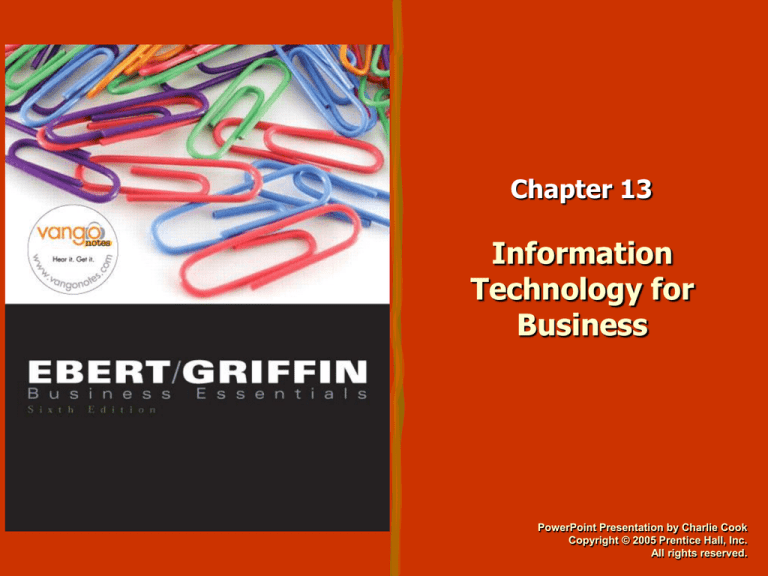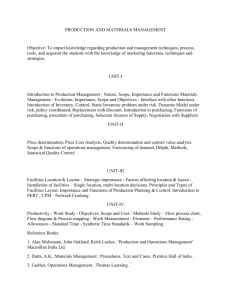
Chapter 13
Information
Technology for
Business
PowerPoint Presentation by Charlie Cook
Copyright © 2005 Prentice Hall, Inc.
All rights reserved.
Key Topics
• Information vs. Data
• The evolution from functional system to ERP
• Databases and how they are used
• Information system application programs
• Communications technology
Copyright © 2005 Prentice Hall, Inc. All rights reserved.
12–2
Information Management
• Managing internal information resources to
support business performance and outcomes
Information Manager manages the Information
System AND
Turns mountains of data into useable information
Memo to Sales Manager:
You have $250,000 of
sales on backorder.
$175,000 is available to
ship now.
Copyright © 2005 Prentice Hall, Inc. All rights reserved.
Signed,
Data Analyst
12–4
Major Systems By Level
• Executive support systems
Top-level quick data source
• Management information
systems
Customized repeating reports
• Decision support systems
Ideal distribution location
• Artificial intelligence and
expert systems
Backorder management
Resume screening
Copyright © 2005 Prentice Hall, Inc. All rights reserved.
12–5
Evolution of IS Scope
1.
One sales person uses contact management software to track
customer information
2.
A Sales Manager has her team implement the software and tracks
contact frequency, sales per account, etc.
3.
The company bases forecasts, sales people hiring, and future
direction based on this information
4.
Similar progressions happen in other departments. When these
are brought together and integrated, an enterprise resource
Figure 12–1
Copyrightplanning
© 2005 Prenticesystem
Hall, Inc. All rights
reserved.
12–6
is the result.
Evolving from departments to ERP
Enterprise Wide Data
Base (eg Oracle)
Purchasing
system
Front
End Distribution
system
Front
End
Sales
system
Front
End
Forecasting
Accounting Front
system
End
system
Front
End
Personnel
system
Front
End
Enterprise Applications Integration
Copyright © 2005 Prentice Hall, Inc. All rights reserved.
12–7
From ERP to Supply Chain Management
Suppliers
Customers
Enterprise Wide Data
Base (eg Oracle)
Purchasing
Sales
Distribution
Copyright © 2005 Prentice Hall, Inc. All rights reserved.
Forecasting
Accounting
Personnel
12–8
What can you do with such a database?
• Retrieve sales data from your customers at point
of sale
• Relay that information to the sales force
• Forecast sales based on your customers’ sales
• Relay forecasts to purchasing department
• Place forecasts with suppliers and distribution
• When an order is finally placed, all parties
concerned are ready to fulfill, process, ship, and
sell.
Copyright © 2005 Prentice Hall, Inc. All rights reserved.
12–9
New paradigm created by an enterprise
wide database
• Leaner
organizations
• More flexible
operations
• Increased
collaboration
• Information security
Copyright © 2005 Prentice Hall, Inc. All rights reserved.
12–10
Information Systems and Strategy
• The proper information system enables the
chosen strategy.
• Too expensive of a system breaks the business
Eg bike.com
• Too simplistic a system hinders growth
Mom & pop flowers
• The right match of functionality and flexibility
becomes a competitive advantage
Eg Wal Mart, Dell
Have you ever tried to business and had the other
party say “Call back when our computers are up”?
Copyright © 2005 Prentice Hall, Inc. All rights reserved.
12–22





